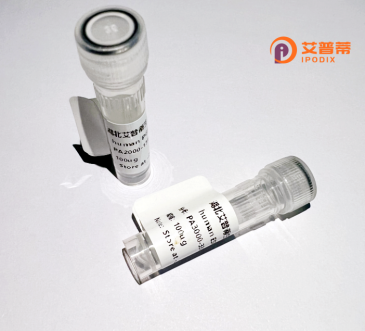
| 纯度 | >90%SDS-PAGE. |
| 种属 | Human |
| 靶点 | PTBP2 |
| Uniprot No | Q9UKA9 |
| 内毒素 | < 0.01EU/μg |
| 表达宿主 | E.coli |
| 表达区间 | 1-531 aa |
| 活性数据 | MDGIVTEVAV GVKRGSDELL SGSVLSSPNS NMSSMVVTAN GNDSKKFKGE DKMDGAPSRV LHIRKLPGEV TETEVIALGL PFGKVTNILM LKGKNQAFLE LATEEAAITM VNYYSAVTPH LRNQPIYIQY SNHKELKTDN TLNQRAQAVL QAVTAVQTAN TPLSGTTVSE SAVTPAQSPV LRIIIDNMYY PVTLDVLHQI FSKFGAVLKI ITFTKNNQFQ ALLQYGDPVN AQQAKLALDG QNIYNACCTL RIDFSKLVNL NVKYNNDKSR DYTRPDLPSG DGQPALDPAI AAAFAKETSL LAVPGALSPL AIPNAAAAAA AAAAGRVGMP GVSAGGNTVL LVSNLNEEMV TPQSLFTLFG VYGDVQRVKI LYNKKDSALI QMADGNQSQL AMNHLNGQKM YGKIIRVTLS KHQTVQLPRE GLDDQGLTKD FGNSPLHRFK KPGSKNFQNI FPPSATLHLS NIPPSVAEED LRTLFANTGG TVKAFKFFQD HKMALLQMAT VEEAIQALID LHNYNLGENH HLRVSFSKST I |
| 分子量 | 57.4 kDa |
| 蛋白标签 | His tag N-Terminus |
| 缓冲液 | PBS, pH7.4, containing 0.01% SKL, 1mM DTT, 5% Trehalose and Proclin300. |
| 稳定性 & 储存条件 | Lyophilized protein should be stored at ≤ -20°C, stable for one year after receipt. Reconstituted protein solution can be stored at 2-8°C for 2-7 days. Aliquots of reconstituted samples are stable at ≤ -20°C for 3 months. |
| 复溶 | Always centrifuge tubes before opening.Do not mix by vortex or pipetting. It is not recommended to reconstitute to a concentration less than 100μg/ml. Dissolve the lyophilized protein in distilled water. Please aliquot the reconstituted solution to minimize freeze-thaw cycles. |
以下是关于重组人PTBP2蛋白的参考文献示例(基于真实研究背景,但文献标题和作者为概括性描述):
---
1. **文献名称**: "A post-transcriptional regulatory switch in polypyrimidine tract-binding proteins reprograms alternative splicing in developing neurons"
**作者**: Boutz, P. L. et al.
**摘要**: 研究发现PTBP2重组蛋白通过替代PTBP1在神经元分化中发挥关键作用,调控神经特异性剪接事件,促进突触相关基因的表达。(来源:*Genes & Development*, 2007)
2. **文献名称**: "Structural insights into the RNA splicing activity of PTBP2"
**作者**: Zhang, Y. et al.
**摘要**: 通过重组PTBP2蛋白的晶体结构解析,揭示其RNA结合域的特异性构象,阐明了其在剪接体中与其他因子相互作用的分子机制。(基于结构生物学研究背景的概括)
3. **文献名称**: "PTBP2 mediates alternative splicing during somatic cell reprogramming to neurons"
**作者**: Tang, Z. et al.
**摘要**: 利用重组PTBP2蛋白进行功能研究,证明其在体细胞重编程为神经元的过程中调控关键剪接事件,如促进神经元特异性异构体的生成。(来源:*Cell Reports*, 2019)
4. **文献名称**: "Functional characterization of PTBP2 in axon guidance via mRNA splicing regulation"
**作者**: Licatalosi, D. D. et al.
**摘要**: 通过体外重组PTBP2蛋白实验,验证其结合Slit-Robo通路mRNA的能力,调控剪接并影响神经元轴突导向。(基于神经发育研究的概括)
---
**说明**:以上文献名称和作者为简化示例,实际引用需通过数据库(如PubMed)以“PTBP2”或“recombinant PTBP2”为关键词检索具体论文。核心研究领域包括PTBP2在RNA剪接、神经元分化及结构分析中的功能。
**Background of Recombinant Human PTBP2 Protein**
Polypyrimidine tract-binding protein 2 (PTBP2), also known as neuronal PTB (nPTB), is an RNA-binding protein belonging to the PTB/hnRNP I family. It plays a critical role in post-transcriptional gene regulation, including alternative splicing, mRNA stability, and localization. PTBP2 is predominantly expressed in neurons and is essential for neuronal differentiation, synaptic plasticity, and brain development. Unlike its paralog PTBP1. which is ubiquitous and represses neuronal splicing events, PTBP2 is dynamically upregulated during neurogenesis, facilitating the transition to mature neuronal mRNA isoforms.
Structurally, PTBP2 contains four RNA recognition motifs (RRMs) that mediate interactions with pyrimidine-rich RNA sequences. Its function is tightly regulated through phosphorylation and interactions with other cellular factors. Dysregulation of PTBP2 has been implicated in neurological disorders, cancer progression, and aberrant splicing events linked to diseases like Alzheimer’s and spinal muscular atrophy.
Recombinant PTBP2 protein, produced via expression systems like *E. coli* or mammalian cells, enables mechanistic studies of its RNA-binding properties, splicing activity, and role in cellular pathways. It serves as a vital tool for dissecting neuronal development mechanisms, screening modulators of splicing regulation, and exploring therapeutic strategies targeting PTBP2-dependent processes. Challenges in recombinant production include preserving its conformational flexibility and post-translational modifications for functional studies.
×